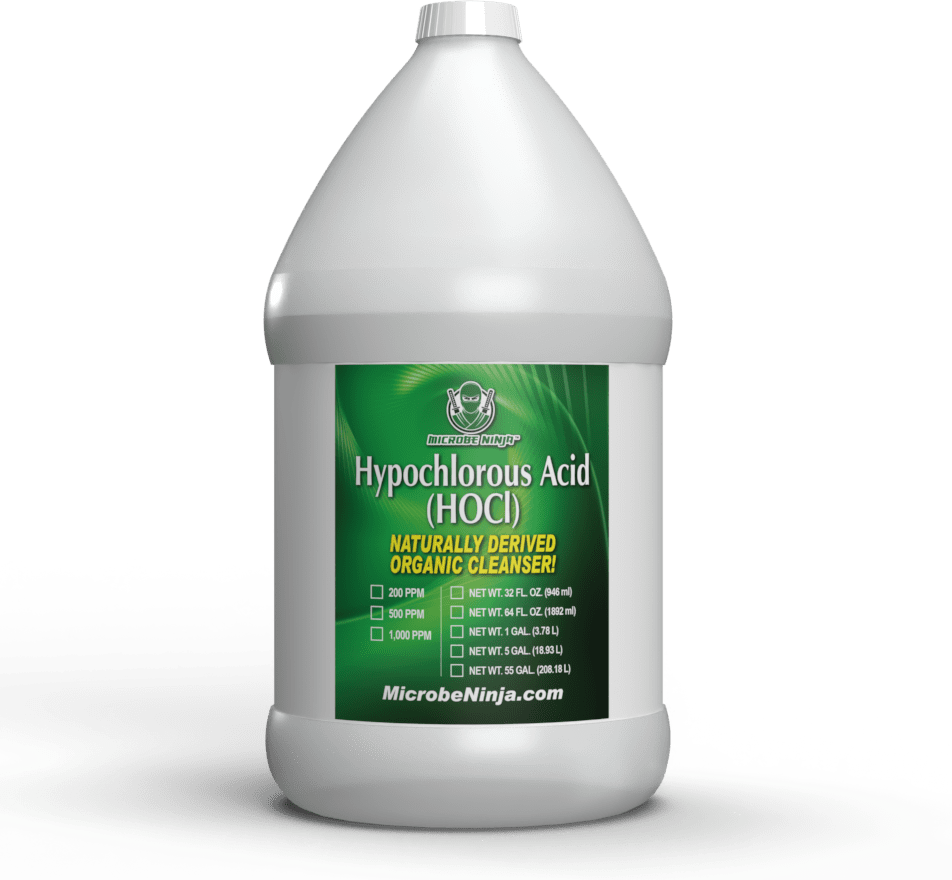Is Hypochlorous Acid the Same as Bleach?
No, although both contain chlorine chemistry, hypochlorous acid (HOCl) and bleach (sodium hypochlorite) are not the same. HOCl is a naturally occurring molecule produced by the human immune system to fight infection. Bleach, on the other hand, is a synthetic alkaline chemical that can be harsh on skin, lungs, and surfaces.
Both are powerful disinfectants, but that’s where the similarity ends. Let’s break down how HOCl and bleach differ in composition, safety, and effectiveness, and why Microbe Ninja’s HOCl technology is leading the next generation of disinfection.
1. The Science Behind Each
What Is Hypochlorous Acid (HOCl)?
Hypochlorous acid is formed when salt, water, and electricity undergo a process called electrolysis — creating a solution that kills 99.9% of bacteria, viruses, and fungi without toxic residues.
It’s so gentle that it’s found naturally inside the human body, produced by white blood cells to defend against pathogens.
✅ Typical concentration: 200–500 ppm
✅ pH range: neutral to slightly acidic (5.0–7.0)
✅ Safety: non-toxic, non-irritating, residue-free
At Microbe Ninja, our NinjaGen Hypochlorous Acid Generator lets you create fresh HOCl on-site for pennies per gallon — perfect for homes, clinics, schools, and food facilities.
What is Bleach?
Bleach (sodium hypochlorite) is an alkaline chlorine compound that disinfects through oxidation, breaking down organic material and pathogens. While effective, its high pH and corrosive nature make it less safe for people, pets, and delicate surfaces.
⚠️ Typical concentration: 50,000–60,000 ppm
⚠️ pH range: 11–13
⚠️ Safety: can irritate skin, eyes, and lungs; produces toxic fumes when mixed with other cleaners.
2. Effectiveness: HOCl vs Bleach
Both kill pathogens — but HOCl is just as effective as bleach at similar or lower concentrations, and often works faster.
| Property | Hypochlorous Acid (HOCl) | Bleach (Sodium Hypochlorite) |
|---|---|---|
| Kills bacteria & viruses | ✅ Yes | ✅ Yes |
| Safe on skin | ✅ Yes | ❌ No |
| Odor / fumes | ✅ Odorless | ❌ Strong chlorine smell |
| Corrosive to metals | ❌ No | ✅ Yes |
| Eco-friendly | ✅ Biodegradable | ❌ No |
| Residue-free | ✅ Yes | ❌ Leaves residue |
| EPA registered | ✅ Yes (HOCl-based disinfectants) | ✅ Yes |
Because HOCl is closer to neutral pH, it penetrates microbe cell walls more efficiently than bleach — without damaging skin, fabric, or surfaces.
3. Safety & Environmental Impact
Bleach is effective but harsh. It can:
- Trigger respiratory irritation
- Corrode metals and discolor fabrics
- Leave behind toxic residues and chloramines when mixed with ammonia or acids
HOCl, on the other hand:
- Is non-toxic and non-flammable
- Safe for people, pets, plants, and food contact surfaces
- Breaks down into salt and water after use
That’s why hospitals, farms, and even food processing facilities increasingly rely on HOCl as a sustainable, safe disinfectant.
4. Practical Uses of HOCl
- Homes: Everyday cleaning, kitchen counters, toys, pet areas
- Healthcare: Surface disinfection, wound cleansing, sanitizing equipment
- Agriculture: Crop protection and post-harvest sanitation
- Hospitality & Schools: Touch-point disinfection and odor control
- Gyms & Wellness Studios: Equipment and air misting
With systems like the NebulaOne Dry-Mist Fogger, you can disinfect rooms, vehicles, and facilities in minutes — safely and without chemical residue.
5. Cost Comparison: HOCl vs Bleach
While bleach is cheap upfront, HOCl can be even more cost-effective in the long term.
By generating or purchasing ready-made HOCl, you eliminate waste, reduce ventilation needs, and avoid surface damage or corrosion costs.
Microbe Ninja offers bulk HOCl liquid sales by the gallon, and when you order two or more gallons, shipping is free — a perfect way to stock up for your home or business.
Microbe Ninja products will soon be available on Amazon and remain on our Microbe Ninja Store, making it easier than ever to order your HOCl solutions online.
6. Common Myths About Hypochlorous Acid
Myth #1: HOCl is just diluted bleach.
❌ False. HOCl and bleach are chemically distinct. Bleach is sodium hypochlorite (NaOCl), while HOCl is a neutral molecule with different oxidation properties and a neutral pH.
Myth #2: HOCl isn’t strong enough to disinfect.
❌ False. HOCl kills 99.9% of germs and viruses — the same pathogens targeted by bleach — and is listed by the EPA as a disinfectant for COVID-19 and other emerging viruses.
Myth #3: HOCl doesn’t last.
✅ True and false. When properly generated and stored (like with NinjaGen’s sealed HOCl generator), it maintains potency for up to 30 days or more, especially when kept in opaque containers away from sunlight.
7. HOCl vs Bleach: The Verdict
Both are proven disinfectants, but HOCl offers the same germ-killing power without the harsh side effects. It’s safe enough to use around people, pets, and plants, yet powerful enough for hospitals and industrial applications.
In short: Bleach disinfects. Hypochlorous acid heals, protects, and sustains.
If you’re ready to make the switch to a safer, smarter disinfectant, explore our NinjaGen Hypochlorous Acid Generator and NebulaOne Fogger or shop our HOCl by the gallon options for effortless eco-cleaning.
Key Takeaway
Hypochlorous acid isn’t just a bleach alternative — it’s the next generation of clean:
Safe, effective, sustainable, and now easier than ever to use.
Clean smarter. Breathe easier. Live safer — with Microbe Ninja.



Comments are closed